
The NeoGeo was a very impressive piece of hardware, well ahead of its time. It was created by SNK of Japan and released in the U.S. in 1990. Unfortunately, it wasn't successful because of its extremely high price tag. It was priced at around $650, with game cartridges costing around $200. The reason for such prices was the high amount of memory the unit and game paks had. Each cartridge could hold a maximum of 330 megabits (or 42 MB) and the system had 56 MBits (7 MB) of RAM. Back then, RAM was quite expensive. Games for the NeoGeo home consoles were the same as those found inside most of SNK's arcade machines, as their arcade machines had a modified NeoGeo hardware within. This was highly appealing to players, as they were playing in their homes the same games that were in the arcades.
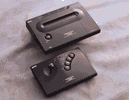 Processor: 68000
Processor: 68000Processor Speed: 14 MHz
Resolution: 320 x 224
Colors: 4,096/65,536
Max Sprite Estimation: 380
Sprite Size: Programable
The Neo Geo is a very unique game system. Since the Neo Geo was first released by SNK back in 1990, practically every title released for the arcade machine (known as MVS, Multi Video System), has also been released as an identical home console version. Why identical, you ask? Because the home cartridge uses the exact same chips as the MVS version, the only difference being that MVS carts use a larger board to prevent cross-compatibilty. Meaning, why would an arcade operator spend $1000 on a new MVS cart when he could get the same homecart for $300? That's why you can't use one on the other.
The Neo Geo Gold System, which consisted of the console, two controllers, and a pack-in game, originally retailed for $699.00, with new games around $250.00. Obviously, this was considered pretty steep at the time, and the Neo Geo didn't sell all that well. Fortunately for everyone, there were enough hard-core Neo Geo fans out there to support the console, and nowadays a used Neo can be found for around $300.

Neo Geo Home System
"Why WAS the system so expensive?" It's really not very expensive anymore, despite what some people may tell you. But it's original high price tag was due to the fact that it had a huge memory capacity. That brings up the price substantially. But also, Neo-Geo takes advantage of "parallel processing."
Parallel processing is a technology that allows one system to utilize two separate CPUs (Central Processing Units) to create one amazing experience. Neo-Geo has one 16-bit 68000 CPU and an 8-bit Z8OA CPU. So how many "bits" is Neo-Geo? Well, it's hard to say. A lot of people will add the two numbers together and say, "The Neo-Geo is a 24-bit system." This is incorrect. You cannot simply add the two numbers. The Neo-Geo would have far less capabilities if it simply had one 24-bit CPU. Others call it a 16-bit system just because of the generation it comes from. Some will say it's 32-bit, simply because it's the next step after 16. None of these would really be accurate. The most correct statement you could make about the Neo-Geo is, "The Neo-Geo has two CPUs. One is 8-bit and the other is 16-bit." There you have it, parallel processing, one of the major technologies that makes the Neo-Geo such a high-power and high-priced unit.
Neo-Geo system specifications
CPU: Z8OA, 68000
Work RAM: Z80(2K), 68000(64K)
Colors Displayed: 65,536 color pallette; 4,096 colors displayed at one time.
Character Capacity: 64 M
Sprite Size: 16X512-1X2
Number of Sprites: 380
Sound Function: 15 sound channels, 7 devoted to real speech
Direct Rom Access Capability: 330
The Neo Geo MVS machine, as mentioned before, is a stand-up arcade machine (pictured below), featuring the exact same games as are available for the home-cart system. There are various types of MVS machines, but the first thing I want to cover is "dedicated" and "non-dedicated" MVS machines.

A Dedicated MVS
A dedicated MVS machine is a machine that was produced by SNK, and was sold as a complete arcade machine, with cabinet, monitor, controllers, wiring, etc. These are red, or red and black, and usually look pretty nice, because their only intended use is Neo Geo. Dedicated MVS machines only came with a 25 inch monitor or larger, so if the monitor's smaller than that, you know for sure it's non-dedicated.
A non-dedicated MVS is a standard arcade machine, meaning it's JAMMA compatible. JAMMA is the industry standard used for wiring arcade machines, made so that arcade operators can replace the "pcb" (the pcb is the circuit board that contains the actual game), and put in a new game, without having to buy a whole new game cabinet.
In the case of the non-dedicated MVS, the machine has a JAMMA compatible "MVS Board" which was purchased by itself, from SNK, to be used with a JAMMA machine (more on MVS boards below). The game cartridge plugs into this board. Non-dedicated machines are a mixed-bag. Some are perfect, with the perfect Neo Geo button configuration, complete with MVS decals (which are made to make the machine look more like the dedicated cabinets), and the marquee header (which is the light up panel at the top of the machine), and some are recycled Street Fighter or Mortal Kombat machines, with button configurations TOTALLY inappropriate for Neo Geo.
Also, if you see a Japanese MVS for sale, be sure you know exactly what you are getting. Japanese MVS machine are "sit down" machines, meaning that they require a bench or seat in order to play them (unless you're a midget).

Japanese MVS
MVS boards, as I mentioned before, are purchased from SNK for use with a JAMMA arcade cabinet. There are 6 different versions of the MVS board available. I should point out again that MVS stands for "Multi Video System". The reason is, some MVS boards have more than one cartridge slot, meaning the board can hold multiple games, from which the gamer can choose, via the "Select" button. These are the different MVS boards available: 1 slot, 2 slot, 4 slot, 6 slot, and 8 slot and the Mini 1 Slot (MV-1). The Mini 1 Slot is pictured below. (more info about this can be found in the MVS portion of the "System" section, found on the navigation bar below). The more slots the particular board has, the more it will cost, and the same goes for complete arcade cabinets.
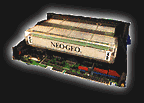
MV-1 Mini One Slot
An option which many have found useful is a machine called a Super Gun, or Super Nova. It is a small unit that allows you to play your MVS board on any standard TV set. The MVS board sits on top of the Nova unit, and it is connected via the JAMMA harness (below) which is a connector, the same one used to connect the board in non-dedicated arcade machines.

JAMMA Harness
The standard Neo controllers plug directly into the MVS board, and the Nova unit is connected to the TV. Most Novas have joystick ports in the Nova itself as well, for use with other JAMMA pcbs. Many have gone this route and found it satisfactory.
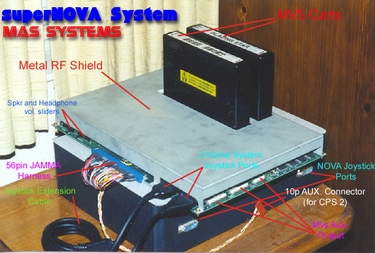
Super Nova w/2 slot MVS Board
In 1995, SNK released the Neo Geo CD in the United States. It is basically the same as the cartridge system, except for the fact that it (obviously) uses CD versions of the cartridge games. The system retailed for around $500, with CD games in the $50 to $75 price range. Almost every game developed for the cart system has a CD version. The Neo CD has some major drawbacks though. One is that you don't get the exact same music as on the cart. Some say it sounds better than the cart, but if you're a purist, it's not for you. The second drawback is that not all the background detail is there on the higher meg games. "High meg" means that it has a very high megabit count (the game's size) which seems to take more processing power. The last, and biggest drawback for the Neo CD (a single speed machine) is the loading time, which on those high meg games can be really exasperating. For example,on some fighting games, it actually stops to load between rounds. If your fight takes 45 seconds and the loading takes 60, you're not going to be a happy gamer. On the older games the loading isn't supposed to be that bad, but even that is on a case-to-case basis. It depends on the game.
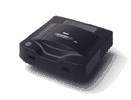
Neo Geo CD
In Japan, SNK later released the Neo Geo CDZ, which was originally thought to be double speed. Some tech experts say that it's not double speed, that it just has a larger cache, which allows it to load faster. I've been told that it doesn't really load that much faster than the original, but I've never played one, so I wouldn't know. Unfortunately the Neo Geo CDZ was never released in the U.S. and can only be acquired as an import, and needs a language switch mod in order to play all games in English. Any Neo CD game will play on any Neo CD, so there aren't any questions of compatibility.
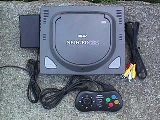
Neo Geo CDZ
The Hyper Neo-Geo 64 is only available as an arcade machine right now. A home version of this system is extremely unlikely. Unlike the original Neo-Geo, the HNG64 is built to support 3-D software. It's much newer. It was first released in 1997. Very few games have been released for it so far. Among them are Samurai Shodown 64, Road's Edge, Beast Busters, and Fatal Fury: Wild Ambition. The future of this system (if any) could be turbulent. So far the system has only been doing well among a small crowd of Neo-Geo fans. The response to such games like Samurai Shodown 64 was much smaller than what SNK was expecting. Keep your eyes peeled for future developments on this new Neo-Geo system.
The portable Neo-Geo! The original version has an 8-tone black & white LCD screen. A newer color version of the system is also available. It is able to exchange game data with Sega's Dreamcast! It allows for a totally new interactive experience when you connect your Neo-Geo Pocket with your Dreamcast!
Like the Hyper Neo-Geo 64, the Neo-Geo Pocket does not play the same games as the cart and CD systems. It plays its own pocket-sized cartridges. The library of available games for this system is already quite impressive!
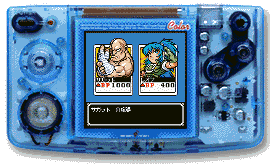
The Neo Geo Pocket
Unfortunately, no new cartridge or CD systems are being manufactured...and even the NeoPocket system/games has been pulled out of the U.S. market. But if you search around, you can get used systems/games or even some that are still sealed. And of course, they still support the Pocket in Japan.
// © 2001 jgpalanca all rights reserved